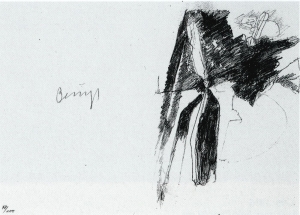
Sandzeichnungen (Sand Drawings)
About This Artwork
In December 1974 Joseph Beuys journeyed to the Indian Coast of Kenya, where he drew large-scale human figures, horses, stags, and mysterious runes and alchemical symbols in the sand. The impression was that the artist was engaged in an animistic ritual or that he was sending messages from the beach. Beuys’s actions were recorded by photographer Charles Wilp, and the images were released as a portfolio that became part of the artist’s celebrated multiples (items made to widely distribute his ideas to the public across a variety of media). Beuys spent a lifetime creating thousands of drawings, building sculptures, and engaging in performances that promoted his belief that art has unlimited potential for the transformation of human action. Sandzeichnungen is an expressive act full of existential affirmation. Here, a figure is implied by the documentation of its action; drawing in the sand is a gesture both timeless and fleeting.





























